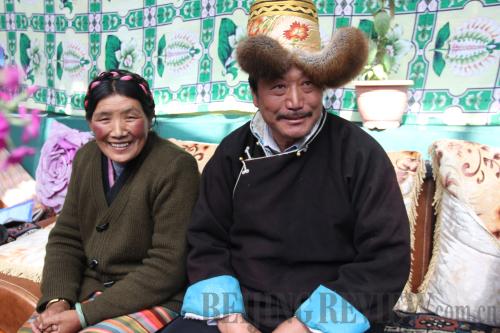|
 |
|
HAPPY COUPLE: Lhaba Toinzhub and his wife Yangzin (MA JING) |
One week before the Tibetan New Year, which fell on March 2 this year, an atmosphere of festivity filled Banjiulunbu Village in the southwest of Gyangze County in Xigaze Prefecture, Tibet Autonomous Region.
A national flag, surrounded by several other wore flags, was flying over the little square at the entrance of the village. Villagers in colorful holiday attire headed toward a big open space at one end of the village. Men and older women mostly wore black blouses with sleeves laced with blue. Women wore striped hand-woven wool aprons.
Young girls, dressed in purple or red blouses, each wore multiple necklaces of various lengths. The necklaces are strung together with precious jewels such as red coral, turquoise, agate and beeswax. It is said that the jewels on one girl can be worth more than 100,000 yuan ($16,500). Both men and women wore traditional fur hats.
In the open space, children merrily chased each other. Middle-aged and elderly women, with hair braided around their heads, were sitting in circles, sipping the barley wine that they had brewed themselves.
The whole village was rejoicing in celebration, except for the herds of sheep, which were quietly grazing in nearly fields stretching all the way to distant mountains. The bells tied to their necks occasionally chimed in the breeze.
A horse race was about to start. The horses were also decorated, with colorful ribbons tied to their reins or wrapped around their tails. After riders galloped along a dusty road to the finish line, they were greeted with an expectant crowd and a toast of barley wine.
Penlog, the 51-year-old village head, shuttled through the crowd to keep things organized. He said that the things they do to welcome the New Year, including the horse race, a tug-of-war and dancing, were scheduled to last from February 23 to 26.
Village life
Among the villagers ushering in the Tibetan New Year is 46-year-old Purchi. She has prepared plenty of yak meat for the holiday and tidied up her house. The two-story building was built with her family's own savings plus 12,000 yuan ($1,951) in the form of subsidy from the government.
Purchi was at home alone. Her husband makes a living knitting Tibetan clothes at home and selling them at his garment shop in Xigaze. He was very busy before the Tibetan New Year as people buy new clothes every year for the celebrations. He has to hire extra help during the busy season. Every year, the business can make 120,000 yuan for the family.
Purchi's three grown children have all left home. Her eldest son is a doctor in the Gyangze County seat, and her younger son works at the Manla Hydropower Station many kilometers away from the village. Her daughter, the youngest of the three, attends a medical university in Shijiazhuang City, north China's Hebei Province, and plans to return to Tibet to work as a doctor in the future, Purchi said, adding that she is content with her current life.
In a house several meters down the road, 51-year-old Lhaba Toinzhub was also ready for the New Year. Sunlight flooded down from the tilted glass roof of his spacious and tidy living room. Several pots full of flowers were blooming.
Lhaba Toinzhub's house has a floor space of 500 square meters, and the living room has sofas that can seat a dozen or so guests.
The family also has three children. The eldest is a police officer in Lhasa, capital of Tibet. The second child, a daughter, lives with Lhaba Toinzhub and his wife, and the youngest child studies at a university in Xi'an City, northwest China's Shaanxi Province.
Lhaba Toinzhub's wife Yangzin said that their life has greatly improved. The family raises four yaks and dozens of sheep. They also operate a shop. But their main income comes from tourism. Every year, the family receives domestic and foreign tourists, who stay at their home to experience the Tibetan lifestyle. According to Lhaba Toinzhub, they serve guests with butter tea and Tibetan style food, and they can make 70,000-80,000 yuan ($11,382-13,008) annually.
Most tourists Lhaba Toinzhub receives came to the village to visit the Pala Manor, a manor once owned by the Pala, a powerful aristocrat family in old Tibet.
| 